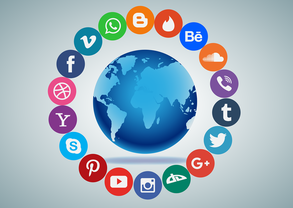 This column first appeared in the December 29, 2019 PRINT edition of The Vindicator and Tribune-Chronicle newspapers: From politics, to privacy, to protection problems, 2019 was tumultuous year in world of social media. Just when we thought it was safe to revisit our favorite social platforms, reports of new security breaches and record-setting fines emerged, as did concerns over efforts (or lack thereof) to protect our kids. Here are a few of the top social stories from 2019: 1. Google/YouTube’s Record Day. As Facebook continues to dig out of the crater it dug in the wake of the 2016 election, other platforms have experienced their own pain. Even with the heaps of negative backlash they endured, Facebook was not the leading culprit this year. 2019’s “Social Media Bad Guy” title goes to Google and YouTube who agreed to pay a record fine of $170 million for alleged violations of the Children’s Privacy Act. It’s not the first time the Federal Trade Commission levied a fine against the Internet giant. In 2012, Google paid out a (then) record $22 million fine to the FTC. The new fine is pennies-on-the-dollar for Google, but the decision will have long-lasting ripple effects—not because of the money lost, but because of the new rules YouTube will have to implement to protect young viewers. Many of the leading creators of children’s content will almost certainly suffer in terms of monetization. Those who make child-centered videos can’t include personalized ads, and can only collect limited data. Of course, those who will suffer the most are the parents who will now struggle to find new, safe, educational, entertaining, and (mostly) free content on the world’s largest streaming video provider. 2. Hiding Like Counts. Top platforms like Instagram and Facebook are dabbling with “hidden like count” algorithms. These tests center on a desire to build healthier social environments by protecting our mental well-being. Instagram started hiding likes for some users in Canada in early-2019, and later in six other countries. Facebook began hiding likes in Australia in late-2019. U.S. users will likely see these changes on both platforms in 2020. But not everyone is happy with the change. Content creators criticized it claiming they use like counts to attract partners and sponsors. However, Instagram CEO Adam Mosseri said, “We’ll make decisions that hurt (Instagram) if they help our user’s health and wellbeing.” 3. Facebook Is (Still) #1. Remember your friends who said they were quitting Facebook? Well, if that happened, Facebook found a way to recoup those losses with new users. This is likely because it’s still the best choice if your goal is to connect with others. Those closest to us often use Facebook. So we often turn to easily accessible applications to manage those relationships. The top choice on that list for many people is Facebook—on a smartphone. According to the Pew Research Center, 81-percent of U.S. adults report owning a smartphone device. That percentage is expected to rise over the next decade as a new generation of smartphone users enter the market. Popular social applications like Instagram and Messenger use Facebook login credentials for access, while merchants use the Facebook login as a starting point for selling goods and services. For these reasons and more, it’s not hard to understand why users still “like” Facebook, even if some won’t admit it publicly.  Jonathan Meath [CC BY-SA (https://creativecommons.org/licenses/by-sa/2.5)] Jonathan Meath [CC BY-SA (https://creativecommons.org/licenses/by-sa/2.5)] This column first appeared in the December 22, 2019 PRINT edition of The Vindicator and Tribune-Chronicle newspapers: Dear Santa, Hope all is well up north and that plans for the annual all-nighter are nearly complete. I’m writing to apologize for the lack of Christmas wish lists you’re seeing from my kids over the last few years. Yes, they still believe in you. All four of them were super excited when I brought home a life-size inflatable yard decoration of you, and they still sing Christmas carols that reference your jolliness. Our 7-year-old doesn’t always make good choices, so wisely, he fears you (in a healthy way). All this aside, they’ve opted to stop writing to you. The reason: online shopping. At first I blamed Jeff Bezos, but I’ve come to realize I’m part of the problem. Our kids are in high demand at the holidays. It’s not just you who’s excited to spoil them. Even before we hit Thanksgiving dinner, family have started asking them what they want for Christmas. I’m OK with that, but online shopping has allowed them to cut out the middleman. Instead of sitting at the table and carefully recording the names of toys from paper catalogs, they tell the aunts and uncles, “Dad’ll send you a link to my Amazon list.” Of course my reaction to our youngest kids (they’re our most fervent Santa believers) was, “Well, how do you know Santa will see it?” This generated two unexpected responses. The first came from my 7-year-old. “You said he sees and knows everything,” he replied. “So, he already knows what’s on my Amazon list.” Touche. The second came from my 9-year-old. “Even if he doesn’t know, you can share it with him, right?” Sadie asked. “You shared it with everyone else. Don’t you have his email address?” (Note to self: find Santa’s email address) None of this would matter if we just wrote normal letters like we did when I was a kid. You know, good ol’ fashioned paper and pencil with the occasional crayon? Instead, everything is high-tech these days. Jeff (sorry, Mr. Bezos) has certainly made it easier for all of the gift-givers. But I fear he’s made wish list writing a little too easy and impersonal. Remember that letter I wrote to you when I was 8? I know you do. It was a brilliant piece of prose and clearly foreshadowed my career as a newspaper columnist. My heart and soul went into that letter. It was a good year for me, as evidenced by the bounty that awaited me under the tree. But in that letter, I also fully admitted to having some naughty moments. That part is missing from the Amazon option. We miss the opportunity to self-reflect. We only get to select some items that Amazon carries — bonus for givers if you pick an Amazon Prime item. For many, self-reflection is an important component to our end-of-year holiday celebrations. We look back to count our blessings, to thank others for their support and to show love and generosity in return. I might be a little late in telling you this. You’ve probably already picked out presents for my kids. Just know that next year we’ll try a little harder. Rather than just list all the stuff we want in the letters (or email) we write to you, we’ll take time for a little introspection. Sincerely, “Little” Adam P.S. Yes, I know you call me "Little" Adam, and I'm okay with that. Just remember that I'm now 6-foot-8, 320-pounds if you're plan to wrap a Pittsburgh Steelers hoodie for me.  This column first appeared in the December 15, 2019 PRINT edition of The Vindicator and Tribune-Chronicle newspapers: I think I have polar bear blood. During most winter days, I feel slightly less comfortable indoors than out. This is probably because of the “malfunctioning” thermostat that slowly increases our home’s temperature throughout the day. I can only assume it’s broken because no one ever admits to changing it. This is also because the cold weather suits me, as do most winter activities. Short winter hikes, sledding and snowball fights, and yes, even shoveling snow are fun for me. It’s good exercise for polar bears. I also enjoy winter travel, driving to see family and friends. Obviously this last activity is a little tricky for a few reasons. In the early part of winter driving season, it takes time for some of us to remember how to navigate snow-covered roads. Our road conditions in northeast Ohio are, at times, treacherous. Even with great road crews—and we have some of the best in the world—it’s tough for any plow or salt truck to stay ahead of rapidly changing weather conditions. But have no fear. For those of us who accept the challenges of winter driving, there’s good news from the social media front. Long time readers may recall my love affair with the social GPS app, Waze. Anyone who listens to me prattle on about driving directions and conditions know that using this app is the only way I can travel. Without it, I would be literally and figuratively lost. Waze is constantly upping its game, adding new features and providing real-time updates about road conditions around the world. Well, most of the world—more than 185 countries—even a few with real polar bears. A new feature released this week makes driving a lot easier for Waze users. We can now see up-to-the-second snow warnings for roads that crews haven’t reached, and instant reports from other users that help Waze reroute us to better road and weather conditions. Waze boasts a great user-friendly interface. If you’re already familiar with the app, look for this new feature by selecting the “Report” icon, then “Hazard,” then “Weather.” Under the weather hazard, you’ll see options for fog, hail, flood, ice on road, and unplowed road. Of course, Waze is best known for community-fed features that include warnings about speed traps and red light cameras, and ever-changing road and traffic conditions like accidents and construction. It’s best to use Waze by entering your destination first. Let the app know where you’re headed so that it knows how to reroute you if the road ahead looks a little dicey. The social GPS was built around the same platform used for Google Maps (Google also owns Waze), so chances are, Waze will work in most locations with good network access. Waze worked the Virginia Department of Transportation to build in this new feature. The hope is that these reports will assist road crews, like ODOT and local agencies and municipalities, more quickly address the roads that need the greatest attention. It might also give first responders an added tool for reaching those in need just a bit faster. Polar bears and other winter drivers can download Waze from the Google Play or Apple’s App Store. It’s free and has minimal in-app advertisements.  This column first appeared in the December 8, 2019 PRINT edition of The Vindicator and Tribune-Chronicle newspapers: I have an eclectic list of parenting specialists. They’re really good at a job that’s incredibly and increasingly difficult. They care about their kids. They resolve daily conflicts, run to-do lists like efficiency experts, all while maintaining some sanity. Some are family members, or parents of best friends. More recently, I’ve found some parenting models among my neighbors. Case in point: Kristen Rock. We’re community neighbors. We have friends-in-common. We see each other at parties. Our families are nearly identical in terms of wedding dates, number of children, and ages. We’re also Facebook friends of course. When it comes to parenting, Kristen is my new “Saint.” Okay, even Kristen would consider the word Saint an over-exaggeration, but she certainly ranks up there with parents who’ve tried a radical parenting strategy and lived to tell about it. Her recent strategy: cutting the family’s internet and cable service, seemingly overnight and without warning. First, Kristen will tell you it’s not as easy to just cancel these services. Beyond the hour-long phone call with Spectrum customer service, there was concern about how her kids would react. After all, this was not meant to be some Draconian move to punish her kids for playing Fortnite too much, or watching inappropriate programs on YouTube. It was about gaining control. It was about reconnecting as a family, even if it meant disconnecting from some technology (we’ll get back to the “some” part in a moment). “Screen time was in conflict with our idealistic family priorities,” Kristen said. “For our family, we want our kids to be reading every day. We want them practicing, to be playing outside.” “The things we needed as a family were in total conflict because of screens.” Kristen shared with me the pros and cons with cutting the cords—a list she made with Jason the night before. It’s also important to note that they kept “some” access. Mom and Dad kept smartphone data plans, and activated hot spots when necessary. One big pro: cost savings. “We went 80 days without (cable and internet). I looked at our bill. It’s $250-a-month. That’s $3 thousand-a-year.” She estimated they cut screen time by 50-percent. Basic channels were a mainstay for family viewing, with the occasional DVD from a library for movie nights. “When the kids came home from school, it was Family Feud or Ellen.” When commercials were added to the mix, “the pace was kind of relaxing,” she added. Another pro: boredom. “Without (technology), the kids got a little bit bored. That was good. I want my kids to be bored sometimes because it forces them to look for other things to do.” The kids started reading for pleasure, but it was also good for the adults, too. “I couldn’t watch the news at 10:30 at night, which was really refreshing.” Some cons: limited access to sports content, no Google Home access, added stress on smartphones, and difficulty with planning travel. “We also had to rethink our family movie night,” she added. “We had to get a little creative.” Would they do it again? Kristen said the pros definitely outweighed the cons. In fact, the Rocks are already thinking ahead to the next 80 days they’ll take a break from internet and cable.  Author: stux (pixabay.com) Author: stux (pixabay.com) This column first appeared in the December 1, 2019 PRINT edition of The Vindicator and Tribune-Chronicle newspapers: The reasons people give for using social media often leave us scratching our heads. In research, we refer to these “reasons” as motives. Seemingly endless lists of motives fill our academic journals. Reasons we say we use social media run the gamut from sharing updates and maintaining relationship to passing time and, well, pure apathy. Apathy Before you ask, “how can apathy be a motivation,” consider the times you’ve used social media out of sheer boredom. When there’s nothing better to do, we light up our smartphones, and scroll and click away. I sat in a doctor’s office for an hour a few weeks ago. If not for a smartphone, I may have been slightly more agitated by the delay. I’m not ashamed to say that passing time look over social media feeds served as a sort of pacifier. Habit Some respondents tell us they use social media out of habit. It’s a ritual. It’s the first thing they do in the morning, or maybe the last thing they see before going to sleep. It’s part of a daily routine. Some claim that it’s a good habit to have because there’s a purpose to the activity. In other words, they go on social media because they have business to do, they know what apps they need to use, and they’re efficient (i.e., they get done what needs to be done in a short amount of time). Validation Some look at motives through the lens of a specific platform like Facebook or Twitter. In a recent issue of the Journal of Social Media in Society, researchers Pavica Sheldon and Megan Newman explored the reasons why teens use Instagram. Among the reasons, usual suspects like social interaction, self-promotion, and creativity emerged as leading motives why teens reported using the photo-sharing site. Regardless of age, these seem like reasons most of us would use Instagram. But these teens also reported an excessive “reassurance-seeking” motive. This motive included items like, “I often ask other people if they think that my clothes looks OK,” “I often ask people if I look attractive,” and “I often ask people if other people like me.” When we read these statements, it’s probably easy to think of some adult friends who use it for the same reasons (even if they won’t admit it). Relationships All reasons pale in comparison to the king of all motives: maintaining relationships. This is by far the most popular reason people give for using social media, and it makes nearly every list of every study. But even that motive is bit little tricky. This is because we’re not entirely sure how respondents define the words “maintain” and “relationships.” We might define those words differently depending on who we are (age, gender, life status, etc). For example, are we really maintaining relationships with people we haven’t see in 20 or 30 years simply because we occasionally like each other’s posts? Maybe, but we’re certainly not cultivating the relationship. It doesn’t make the reason less valid, just a bit confusing when we lump those relationships in with close friends and family members. Do you have different reasons for using social media than what’s listed here? Please share them with me and we’ll explore a few in future columns. |
AuthorDr. Adam C. Earnheardt is special assistant to the provost and professor of communication in the department of communication at Youngstown State University in Youngstown, OH, USA where he also directs the graduate program in professional communication. He researches and writes on a variety of topics including communication technologies, relationships, and sports (with an emphasis on fandom). His work has appeared in Mahoning Matters as well as The Vindicator and Tribune-Chronicle newspapers. CategoriesArchives
July 2023
|
 RSS Feed
RSS Feed